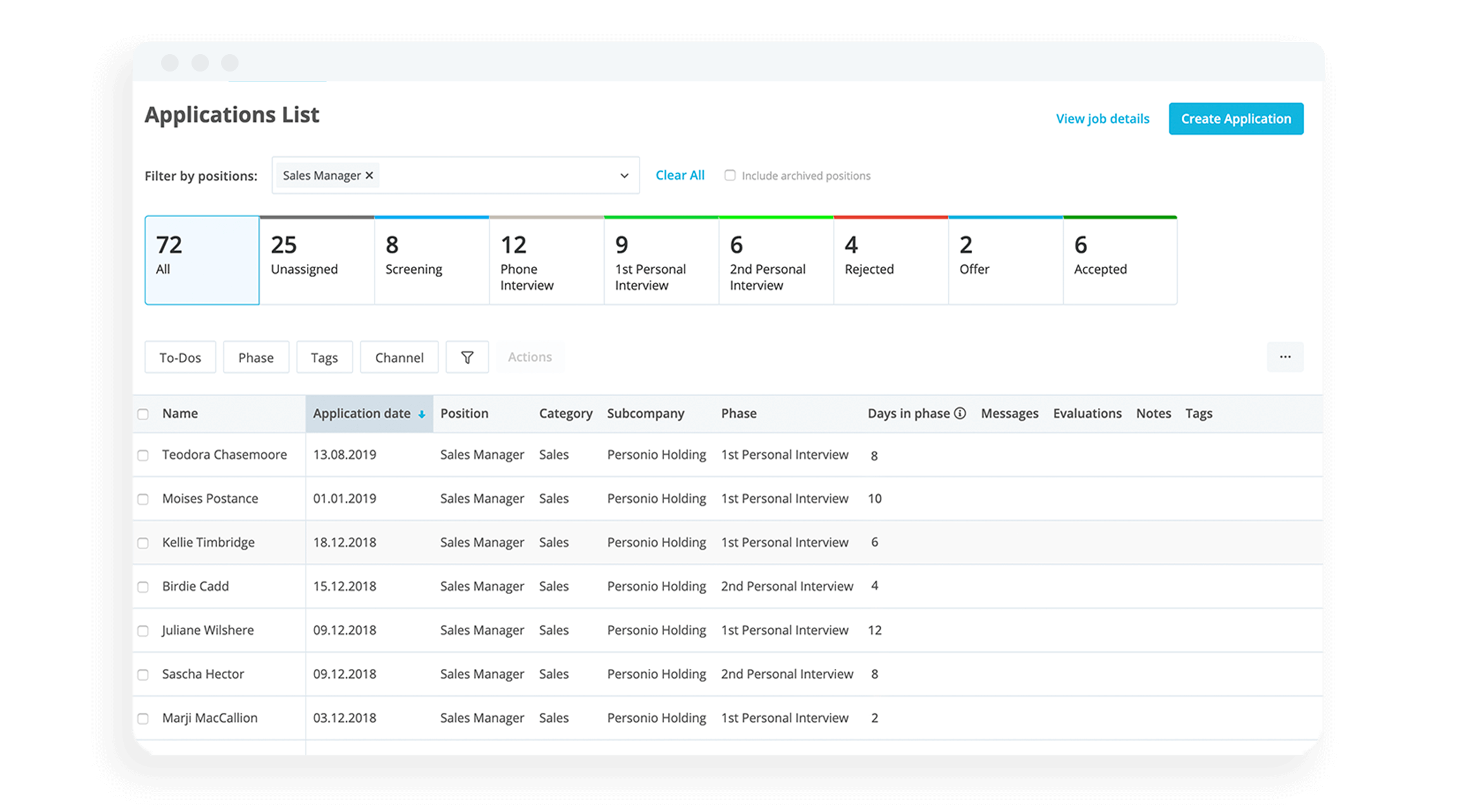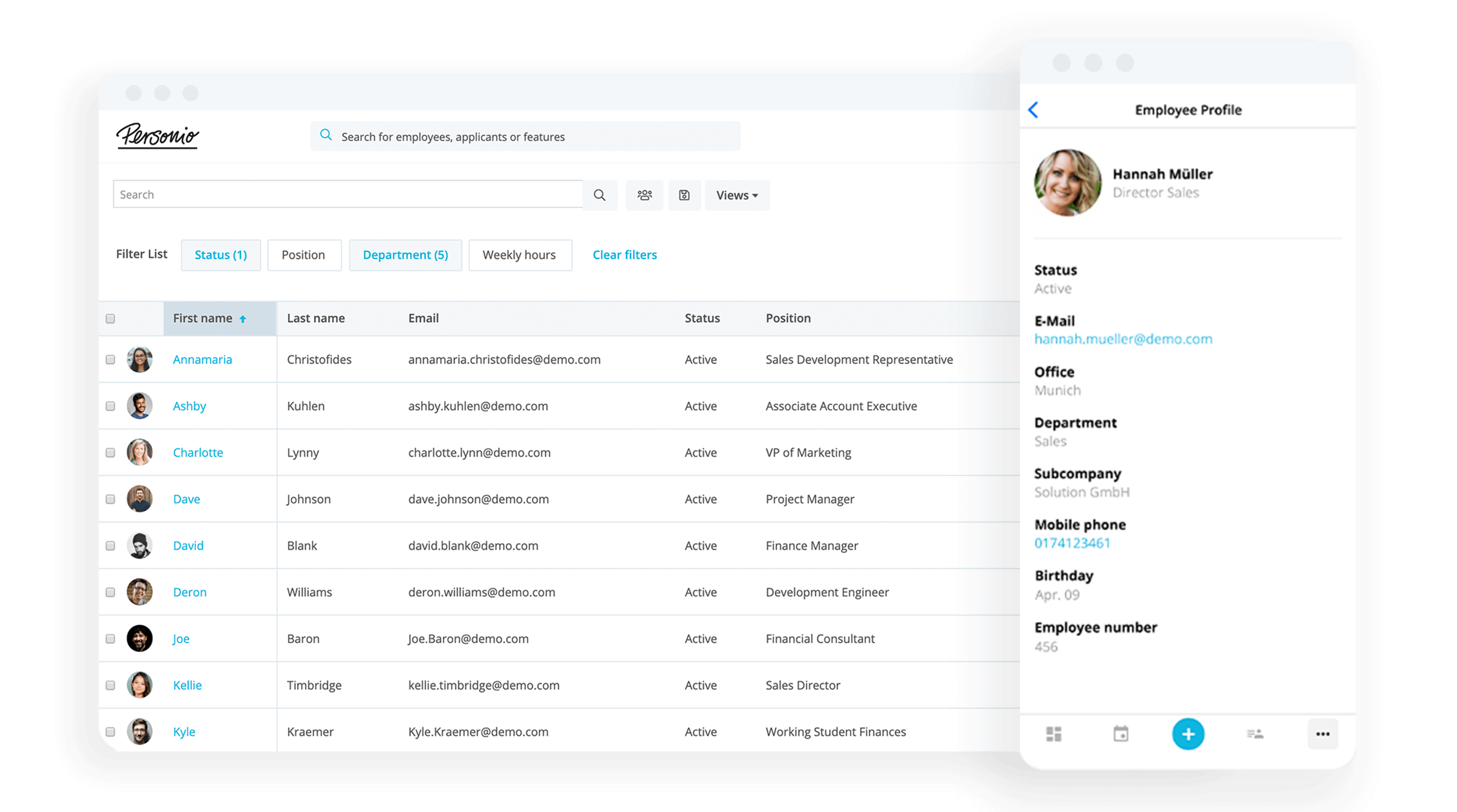
Candidate Assessment
Evaluate candidates with our helpful template.
Latest Blog Posts
Using Assessment Centres to Supercharge Recruitment

While an assessment centre may require considerable effort, it can pay off when it comes to gaining a bigger picture of talent across your organization. But, their success hinges on careful and thought-out planning, implementation, and reporting. In this article, we dive into those specific tasks and how to construct a great assessment centre.
Access candidate details and streamline your processes from one place: Personio.
What Is An Assessment Centre?
An assessment centre is an approach to appraising or evaluating job applicants, involving a complex assessment process. It refers to a method for gauging how suitable a candidate is for a given position. Assessment centres are sometimes referred to as recruiting days, selection seminars, selection processes or testing processes.
Who Should Use An Assessment Centre?
The use of assessment centres typically varies by company size. For most SMEs, they will use an assessment centre predominantly for selecting personnel. Large enterprise companies, on the other hand, may also use it for internal development and mobility. These are not mutually exclusive, though.
Who Runs An Assessment Centre?
Assessment centres can be conducted by companies on their own or with the support of external service providers (e.g. consultants). Candidates are confronted with and evaluated on various tests, either individually or in groups. Tasks can range from individual interviews to situational role-playing.
The Top Benefits Of An Assessment Centre
In short, assessment centres are helpful when it comes to improving the quality of forecasts regarding a candidate's future performance.The idea is to find out whether a candidate is a good fit in terms of both expertise and personality, which means that assessments cover both hard and soft skills.
Companies often recruit experienced observers for this purpose, such as psychologists or consultants who are experienced in engaging with employees and whose perception is trained on assessment matters.
Another benefit of assessment centres is that they allow participants to be compared to one another. This makes decisions easier and offers greater transparency, as the extent to which qualifications and social competencies have contributed to or prevented employment is clear to both candidates and employers.
This is far more preferable to a recruiter’s gut feeling or personal opinion.
One Tool For Each & Every Applicant In Personio

Keep track of all your candidates, and where they stand in the process, by centralising your recruitment efforts in Personio. Click the button below to see it in action.
Applicant Tracking With Personio
How Does An Assessment Centre Work?
An assessment centre involves candidates completing a series of individual or group tasks.
The former are mainly standardized tests designed to show whether a candidate is suitable for the advertised position based on measurable criteria. Individual tests can also be used to assess an applicant’s general knowledge, concentration, creativity, logical thinking and personality.
During group tasks, several or all candidates work on a single task at the same time. This allows prospective employers to compare applicants and assess their social skills.
There are various testing formats that companies can use. These can also be modified and combined depending on the objectives of the testing, the available resources and the number of participants.
Formats For Aptitude Tests
Introduction
Presentation
Mailbox exercise (intelligence and concentration tests have also proven helpful)
Group discussion
Roleplay
Case study
Interview/self-assessment
What benefits do the various formats bring, and what do they look like in practice?
Assessment Centre Example
The following table provides you with details on the various tests together with practical examples for use in your own company…
No. 1: Introduction

An initial round of introductions allows candidates to get to know each other and ensures that employers gain a first impression of candidates’ rhetorical abilities, manners and body language. As part of these introductions, candidates should present their resumes and an overview of their personal background.
However, you should get things going before candidates introduce themselves, that is you need to welcome participants, introduce the company and give an overview of what’s ahead.
No. 2: Presentation

At the presentation stage, candidates give a presentation about a set topic. This may be a political, business or social topic, something from the industry or the specific work environment.
This exercise is about giving an objective presentation, not an opinion piece. For a "pressure test presentation,” applicants are only given little preparation time to test their ability to cope with stress. Critiques and questions are permitted during the presentation to increase the pressure even further.
No. 3: Mailbox Exercise

The term “mailbox exercise” reflects the fact that, with this type of test, candidates are presented with a full mailbox containing plenty of to-dos and deadlines, etc. All of these need to be dealt with quickly, which requires candidates to be decisive and demonstrate their organizational skills.
Mailbox exercises simulate a work situation to test organizational skills and decisiveness under stress. They give candidates the opportunity to show that they are able to work well under time pressure.
Those setting the task can increase the pressure further by adding more things to be dealt with on short notice.
The exercise is followed by an interview during which the candidate explains why they responded the way they did.
No. 4: Group Discussion

This task involves a simulated interaction with colleagues or a customer. This may be a difficult discussion with a customer or employee where unpleasant matters need to be dealt with.
The task tests candidates’ social skills, empathy, ability to deal with conflict and willingness to compromise.
The type of situation reflected in the simulation will depend on the position to be filled. Managers are more likely to be confronted with a situation involving a dialogue with an employee than somebody about to start in sales.
Candidates need to take hierarchical relationships into account and interact appropriately.
No. 5: Roleplay

Applicants and assessors generally simulate a dialog situation, for example a meeting with an employee or a sales discussion with a customer. Assessors may respond aggressively at times to test how candidates respond under stress. Candidates need to remain calm and not react impulsively.
You can put candidates’ problem-solving skills to the test with assessment center exercises.
No. 6: Case Study

Case studies are suited for both individual and group exercises. In both cases, candidates need to solve a specific problem related to the company’s practical context and are provided with relevant materials.
During this exercise, candidates are tested for their specialist knowledge and problem-solving skills – after all, they need to analyse and resolve a problem within a short period of time.
Candidates need to demonstrate that they are able to approach their task analytically and strategically. If the case study is a group task, assessors can observe the role participants take on within the team.
The exercise concludes with questions about the suggested solution to elucidate how candidates proceeded to solve the problem. They need to provide reasons why they decided on one solution rather than another.
No. 7: Interview/self-assessment

An assessment centre concludes with an extensive individual interview, where candidates sit down opposite one or several assessors for a review of how the day went.
Candidates are invited to share a self-assessment, where they explain how satisfied they are and why. This exercise requires confidence, but self-praise won’t leave a good impression.
In addition to their self-assessment, candidates are asked to talk about their strengths, weaknesses and motivation, with the assessor(s) being able to ask critical questions at any time.
Online Assessment Centre
Online assessments are aptitude tests that applicants are able to take from their home computers. Candidates complete a range of tests tailored to the respective job opening: Somebody applying for a management accounting job will be given mathematical and logical tasks, while candidates for marketing jobs will be asked to solve creative problems.
Like analogue tests, this process is designed to paint a comprehensive picture of candidates, and it, therefore, tests the following aspects:
Cognitive abilities such as language skills, logical thinking and concentration
General knowledge
Foreign language skills
Mathematical skills, spatial thinking
Personality
Cultural Fit: How well does the applicant fit into the company’s culture?
General Considerations for Online Assessments
Each online assessment is different, and not all tasks are presented every time. Before each task, applicants are always given instructions, all necessary information and a sample practice task.
Some tests need to be completed within a time limit. If this is the case, a clock should be clearly visible, showing both the remaining time and the progress made.
Evaluation
Once the online assessment has been completed, candidates are taken to a page letting them know what comes next. The information provided can be as simple as a statement that the company will get in touch with them soon.
Sometimes candidates may also be provided with a feedback report telling them how they did in the various test modules. This is not the final decision yet, though.
Once the company has evaluated all applicants’ results and selected the best, the next step is usually an invitation to a personal interview.
Assessment Centers for Managers
There are assessment centres for applicants to senior management positions. In this case, candidates are subjected to a half-day or longer (maximum three-day) testing process without other applicants being present.
The assessment is usually conducted internally by the company, with observers being invited from HR and the relevant management team, or by external consultants. In the latter case, company representatives are then also invited.
When management positions are to be filled, the process is sometimes also referred to as management audit, where candidates are interviewed intensively by at least two consultants simultaneously over several hours. Alternatively, they can be assessed by a single interviewer over several meetings.
What You’re Testing
Managers generally no longer need to demonstrate that they have the requisite specialist skills. Their assessment focuses more on management qualities such as:
Analytical thinking
Leadership
Management style
Communicative abilities
Focus on outcomes
Candidates often have to complete some form of simulation to demonstrate their abilities, where they are asked to evaluate corporate processes and decisions, identify potential for improvement or coordinate processes.
The assessment of managers also includes a review of their prior performance, which should ideally be documented, e.g. based on 360-degree feedback interviews.
All Of Your Documents: Secure In One Place

Personio allows you to bundle this information easily and transparently. This supports sound decision-making and the efficient management of candidates as they become colleagues.
Applicant Management With PersonioChecklist: How to Prepare an Assessment Centre
Companies are very different and have very different positions available, so selection processes should be similarly individual. They should be aligned with the company’s culture and its current and future staffing needs.
The HR department bears most of the responsibility for designing selection processes. It works together with the different departments and external consultants, if required, to plan and monitor assessment centres. These steps are important to keep in mind for HR managers:
✓ Preparation: Alone Or With a Partner?
Once you have established your needs (e.g. how many new employees are you looking to hire for what sort of roles, etc.), you should clarify whether you want to complete the process on your own or in collaboration with an external service provider. Also, consider whether you intend to use assessment centres on a regular basis. If yes, you should check the external service provider’s availability.
✓ Securing Internal Resources
Regardless of whether you intend to work with or without external support, you need to consider which of your colleagues should participate in the event: Do you need to involve people from HR or managers? Apart from human resources, you’ll also need technology, catering, rooms, etc. It’s best to form a team or a working group and divide tasks among members. Decide who should be part of the team or group.
✓ Invitation
Once you have established the general conditions, you can send invitation letters to participants. This can be done by email; alternatively you can communicate via online forms, which can be provided on a web page created specifically for this purpose, for example. The letter should contain the following:
Information on the duration (generally 1–3 days)
Number of participants (2–20 applicants)
Dress code
Travel and accommodation, if applicable (reimbursement for travel and accommodation costs)
Supporting program
How candidates can prepare
Deadlines – by when do candidates need to respond
✓ Task Preparation
Work with your external partner of by yourself to define which tasks you are planning to set in which sequence. Schedule sufficient time for completing them and provide breaks so that candidates can mingle socially.
✓ Observation
You’ll see how participants act and react throughout the individual exercises, tests and group tasks. One or several observers should be present in each of the assessment rooms at any time to observe and evaluate candidates. You should even use lunch and other breaks to gather impressions (or have them gathered) to produce the most comprehensive candidate profiles you can.
✓ Evaluation
It is recommended that you and the other observers have an exchange about your impressions of the various candidates both during and after the assessment centre. Take notes throughout the event to aid your memory (share this tip with observers at the start).
Sit down together after the event to discuss your individual assessments. If you aren’t too tired, it is best not to leave too much time between the observation and evaluation. The longer you leave it, the more difficult you and your colleagues will find it to recall the event, and important information may get lost.
✓ Candidate Notification
Communicate your decisions in a timely manner, depending on which decisions you have taken and what steps will follow next. Nothing turns applicants off more than waiting, especially when they have given a lot of time to their application and are hoping to be offered a job.
Try to personalize letters and emails as much as possible and be sure to express your thanks to candidates for their participation, regardless of the outcome. Every candidate should retain positive memories, even if they are rejected.
This template contains helpful suggestions for formulating letters of rejection.
Disclaimer
We would like to inform you that the contents of our website (including any legal contributions) are for non-binding informational purposes only and does not in any way constitute legal advice. The content of this information cannot and is not intended to replace individual and binding legal advice from e.g. a lawyer that addresses your specific situation. In this respect, all information provided is without guarantee of correctness, completeness and up-to-dateness.
Download Free Evaluation Forms

